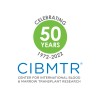
Venetoclax and Azacitidine for the Treatment of Relapsed or Refractory High-Risk Myelodysplastic...
Recurrent Chronic Myelomonocytic LeukemiaRecurrent Myelodysplastic Syndrome3 moreThis phase I/II trial investigates the side effects and best dose of venetoclax when given together with azacitidine and to see how well it works in treating patients with high-risk myelodysplastic syndrome or chronic myelomonocytic leukemia that has come back (relapsed) or has not responded to treatment (refractory). Venetoclax may stop the growth of cancer cells by blocking some of the enzymes needed for cell growth. Chemotherapy drugs, such as azacitidine, work in different ways to stop the growth of cancer cells, either by killing the cells, by stopping them from dividing, or by stopping them from spreading. Giving venetoclax and azacitidine together may help to control myelodysplastic syndrome or chronic myelomonocytic leukemia.

Venetoclax + Cytarabine Versus Idarubicin + Cytarabine : Efficacity Assessment as Post-remission...
Acute Myeloid LeukemiaFor the FILO group, the standard of care for induction chemotherapy of elderly fit patients with AML is represented by the combination of Cytarabine, Idarubicin and Lomustine. The superiority of this combination was confirmed in a larger prospective study the LAMSA-2007. This induction treatment, followed by six courses of consolidation (Idarubicin and Cytarabine) followed then by a period of 6-month maintenance therapy, allows up to 80 % of remission, and a RFS of 46 % at 2 years. The aim of the study is to assess the efficacy on outcome of Venetoclax combined with Cytarabine versus Idarubicin combined with Cytarabine administered as post-remission therapy to elderly patients with acute myeloid leukemia in first complete remission (CR) following induction chemotherapy.

Venetoclax + Azacitidine vs. Induction Chemotherapy in AML
Acute Myeloid LeukemiaThis research is being done to assess the therapeutic activity of a promising combination (azacitidine and venetoclax) versus conventional cytotoxic chemotherapy in induction-eligible patients with acute myeloid leukemia. This study involves the following: Venetoclax and azacitidine (investigational combination) Cytarabine and idarubicin or daunorubicin (per standard of care) or Liposomal daunorubicin and cytarabine (per standard of care)

Safety and Efficacy Evaluation of Bosutinib Plus Atezolizumab in Newly Diagnosed Chronic Leukemia...
Chronic Phase-Chronic Myeloid LeukemiaThe combination of bosutinib plus atezolizumab in first line treatment in newly diagnosis chronic-phase CML patients could potentially increase molecular responses and therefore treatment discontinuation probabilities in these patients. We propose an Open-Label Phase Ib/II Study of Bosutinib in Combination with Atezolizumab for the Treatment of New Diagnosis Chronic Phase-Chronic Myeloid Leukemia Patients.

Physical Fitness Impact of Early Physiotherapy Intervention With a Standardized Exercise Therapy...
Acute LeukemiaThis study aimed to investigate the impact of Physical therapy in adult patients receiving intensive induction chemotherapy for the treatment of acute leukemia during prolonged hospitalization. The study cohort included 150 patients. Primary objective is to compare the effect of a standardized rehabilitation program on physical deconditioning. This study has several secondary objectives of comparing and analyzing the status of sarcopenia, muscle strength, physical performance and the psychic dimension of this intervention. The 6 minutes walking test, Handgrip strength, impedance measurement, computed tomography, Short Physical Performance were used as measures of physical function. Hospital Anxiety and Depression Scale and European Organization for the Research and Treatment of Cancer-Quality of Life-Questionnaire-30 (EORTC-QLQ-30) were used as measures of depression and anxiety and quality of life of cancer patients. To investigate the impact of physical therapy, patients were assigned to the physical therapy group (experimental group) or the control group.These results will thus make it possible to promote access to physiotherapy and rehabilitation care, from diagnosis and during hospitalization, and to standardize practices.

HLA-Mismatched Unrelated Donor Hematopoietic Cell Transplantation With Post-Transplantation Cyclophosphamide...
Acute Lymphoblastic LeukemiaAcute Myelogenous Leukemia6 moreThis is a prospective, multi-center, Phase II study of hematopoietic cell transplantation (HCT) using human leukocyte antigen (HLA)-mismatched unrelated donors (MMUD) for peripheral blood stem cell transplant in adults and bone marrow stem cell transplant in children. Post-transplant cyclophosphamide (PTCy), tacrolimus and mycophenolate mofetil (MMF) will be used for for graft versus host disease (GVHD) prophylaxis. This trial will study how well this treatment works in patients with hematologic malignancies.

A Phase 1 Study of SH1573 Capsules in Subjects With Refractory or Relapsed Acute Myelogenous Leukemia...
Acute Myelogenous LeukemiaAn open label single-arm clinical trial to evaluate the safety, tolerability, PK, PD, and preliminary efficacy of SH1573 in subjects with advanced relapsed, refractory acute myelogenous leukemia that harbor an IDH2 mutation.

Venetoclax, Dasatinib, Prednisone, and Rituximab for the Treatment of Newly Diagnosed or Relapsed...
B Acute Lymphoblastic LeukemiaB Acute Lymphoblastic Leukemia With t(9;22)(q34.1;q11.2); BCR-ABL11 moreThis phase Ib trial studies the effects of venetoclax in combination with dasatinib, prednisone, and rituximab in treating patients with Philadelphia chromosome positive acute lymphoblastic leukemia that is newly diagnosed or that has come back (relapsed). Venetoclax may stop the growth of cancer cells by blocking Bcl-2, a protein needed for cancer cell survival. Dasatinib may stop the growth of cancer cells by blocking some of the enzymes needed for cell growth. Anti-inflammatory drugs, such as prednisone lower the body's immune response and are used with other drugs in the treatment of some types of cancer. Rituximab is a monoclonal antibody that may interfere with the ability of cancer cells to grow and spread. Giving venetoclax in combination with dasatinib, prednisone, and rituximab may help treat patients with newly diagnosed or relapsed Philadelphia chromosome positive acute lymphoblastic leukemia.

Pharmacokinetic and Safety Study of MRX-2843 in Adolescents and Adults With Relapsed/Refractory...
Acute Myeloid LeukemiaAcute Lymphoblastic Leukemia1 moreThis is a Phase I, open-label, non-randomized, dose escalation study in adolescents and adults with relapsed/refractory acute myeloid leukemia, acute lymphoblastic leukemia, or mixed phenotype acute leukemia. Patients will receive continuous oral MRX-2843 in 28 day cycles at predefined dose cohorts.

Asciminib Roll-over Study
Chronic Myelogenous LeukemiaLeukemia3 moreThis is a long term safety study for patients who have completed a Novartis sponsored asciminib study and are judged by the investigator to benefit from continued treatment
